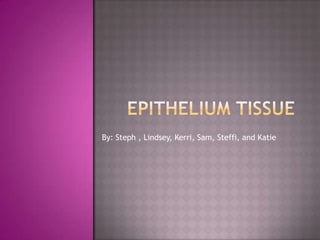Epithelium tissue
•Télécharger en tant que PPTX, PDF•
5 j'aime•2,362 vues
Signaler
Partager
Signaler
Partager

Recommandé
Histology of the pancreas, gall bladder and appendix by Zachariah RichardHistology of the pancreas, gall bladder and appendix by Zachariah Richard

Histology of the pancreas, gall bladder and appendix by Zachariah RichardAhmadu Bello University, Zaria, Nigeria.
Contenu connexe
Tendances
Histology of the pancreas, gall bladder and appendix by Zachariah RichardHistology of the pancreas, gall bladder and appendix by Zachariah Richard

Histology of the pancreas, gall bladder and appendix by Zachariah RichardAhmadu Bello University, Zaria, Nigeria.
Tendances (20)
Histology of the pancreas, gall bladder and appendix by Zachariah Richard

Histology of the pancreas, gall bladder and appendix by Zachariah Richard
HISTOLOGY: EPITHELIA AND GLANDS CONNECTIVE TISSUE PROPER CARTILAGE AND BONE

HISTOLOGY: EPITHELIA AND GLANDS CONNECTIVE TISSUE PROPER CARTILAGE AND BONE
Histology (histology of mouth, pharynx, oesophagus, stomach, duodenum)

Histology (histology of mouth, pharynx, oesophagus, stomach, duodenum)
En vedette
En vedette (20)
Lesions of oral mucosa in children By Dr Sachin Rathod

Lesions of oral mucosa in children By Dr Sachin Rathod
Similaire à Epithelium tissue
Similaire à Epithelium tissue (20)
13 Surgical Infections of the Skin and Subcutaneous Tissues.pptx

13 Surgical Infections of the Skin and Subcutaneous Tissues.pptx
№ 6. Histo. respir. system. Skin & Their Derivatives.pptx

№ 6. Histo. respir. system. Skin & Their Derivatives.pptx
SKIN SENSORY ORGANThe human skin is the external covering of the .pdf

SKIN SENSORY ORGANThe human skin is the external covering of the .pdf
Plus de slehsten0806
Plus de slehsten0806 (9)
"Because i could not stop for death" by Emily Dickinson

"Because i could not stop for death" by Emily Dickinson
Epithelium tissue
- 1. By: Steph , Lindsey, Kerri, Sam, Steffi, and Katie
- 2. Count the layers Simple: 1 layer Stratified: looks and is several layers Pseudostratified / Transitional: Looks like several layers, but all the cells contact the basement membrane What cell is on the top layer? Squamous: Flat (scaly) Cuboidal: about as wide as it is tall Columnar: much taller than it is wide
- 3. Singlelayer of thin squamous cells resting on a basement membrane Location: Air sac of lungs Forms the walls of capillaries Forms serous membranes Membranes that lines the ventral body cavity and cavity and covers the organs inside it
- 4. This shows single layers of squamous (flat) cells around the air spaces (alveoli) of the lung.
- 5. Location Common in glands and their ducts Forms walls of kidney tubules Covers surface of ovaries • A cluster of ducts in the pancreas • Top layer of the cell is as wide as it is thick
- 6. Location Line entire length of the digestive track from stomach to anus Located in digestive tract
- 7. Nonciliated type in male’s sperm-carrying ducts of large glands; ciliated variety lines the trachea, most of the upper respiratory tract
- 8. 1.Cilia 2.Mucus of goblet cell 3.Pseudostratified epithelium layer 4.(under three) Basement membrane 5.(under four) connective tissue
- 9. Nonkeratinized type forms the moist linings of the esophagus and mouth; keratinized variety forms the epidermis of the skin, a dry membrane.
- 10. Little black dots nuclei, mid-section stratified squamous epithelium, right below that basement membrane, lastly connective tissue
- 11. Lines the ureters, bladder, and part of the urethra Top pinkish purple is the transitional epithelium, and then the lighter purple is the basement membrane, then connective tissue
- 13. Impetigo
- 14. a superficial skin infection characterized by pustules and caused by either Staphylococci or Streptococci.
- 15. pustule Staphylococc i Streptococ ci
- 16. pustule Stratified Squamous Epithelium Cross section of skin
- 23. • Inflammatory, chronically relapsing, non-contagious and itchy skin disorder • Type of eczema • Also known as "prurigo Besnier," "neurodermitis," "endogenous eczema," "flexural eczema," "infantile eczema," and "prurigo diathésique
- 24. Cause is genetic Aggravated by contact or intake of allergens Also influenced by other factors affecting the immune system Ex. stress and fatigue
- 25. Idiopathic- no certain cause Changes in at least 3 groups of genes encoding structural proteins, epidermal proteases and protease inhibitors may lead to a defective epidermal barrier
- 26. can’t keep in moisture can’t keep out irritants disturbs the formation of natural skin oils reduces sweat secretion skin can become so dry that it cracks and fissures develop allowing bacteria and irritants to penetrate the skin possibly cause infection